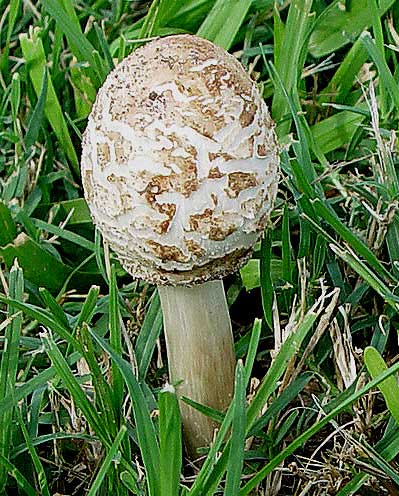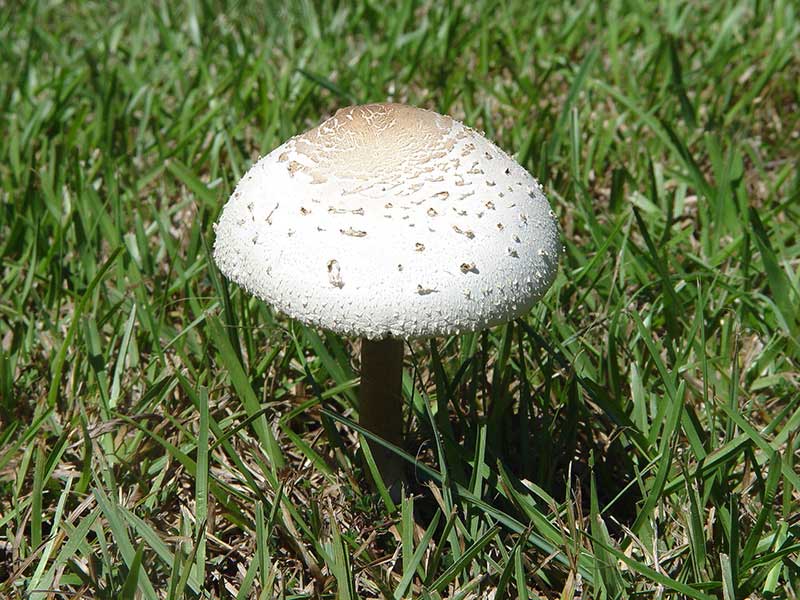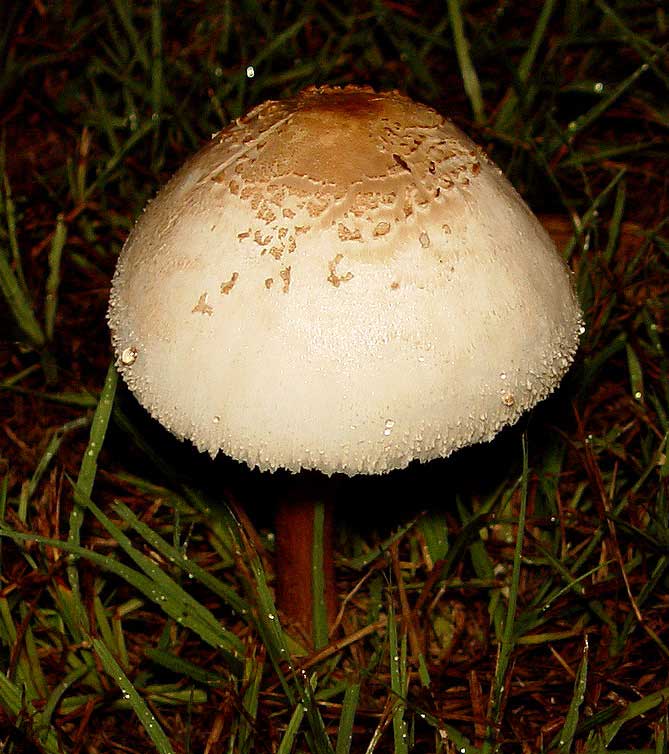RiskVA
Fungus Amungus 27 Sep 2006

Immature Chlorophyllum mushroom sprouting in a lawn. Its cap is still not open.
Fall is not just colorful leaves, cooler days and crisp, star-studded nights. It’s a fungus festival, toadstool time, and mushroom mania for gourmets who are adventurous or carefree enough about balancing a delicious feast against a ghastly death by collecting and eating mushrooms they believe or hope are edible. Collecting mushrooms to eat should be left entirely to the experts.
Every year, especially during spring and fall, mushroom hunters roam the woods in search of delectable dinners. Although there are many edible and wonderfully flavored fungi, there are also a lot of killers along with many more that won’t kill you but will make you so sick you’d wish you were dead. The poisonous Chlorophyllum mushroom illustrated in this article produces severe nausea, diarrhea, disorientation, painful stomach and abdominal cramps, and sometimes death. Each year it is responsible for the largest number of reported mushroom poisoning cases in the United States.
In my case, there are only a very few fungi that I know well enough to eat. Puffballs are one of those. They have no cap, gills, pores, or the usual kind of stalk, and vary from less than an inch to 12 or more inches in diameter. Last Sunday evening, after harvesting several large puffballs from our lawn – one the size of a grapefruit, we sliced them up, sautéed them and sprinkled them with a little salt. Frankly, I gorged myself on their zero-calorie white flesh. After frying, they turned a beautiful golden tan. And although I’d rather have cooked them in butter, we showed restraint and used Pam. Mmmm! Good!
But, just because I eat something doesn’t mean I’m recommending it to you. For Pete’s sake don’t take my word for it. There’s too much at stake if you make a mistake. Unless you’re in a hurry to meet God, do what I do with most fungi. Enjoy them visually. Many mushroom toxins are untreatable, and even if you survive an encounter you may sustain serious and irreversible kidney or liver damage to the point of complete organ failure.
This past week after our brief encounter with that rare moisture called rain, mushrooms and other fungi are popping up all over town. And by the way, all mushrooms are fungi. Think about that the next time you cook up a steak smothered with fungus.
Most people call wild mushrooms toadstools, especially poisonous ones, perhaps from the mythological belief that toads sit on them or reclining in their easy chair, prop up their long hind legs as they relax with a pipe. To me they’re all mushrooms, although some lack the typical stalk and cap and look downright strange.
The mushrooms you see popping up in the lawn, on dead logs, at the base of trees and other places, are only the fruiting structure and only a small part of the entire fungus plant. A vegetative web of widespread, thread-like tendrils called mycelia has been invisibly living and spreading in the soil or dead wood all year round. Fungus mycelia are quite beneficial, assisting in decomposing dead organic matter and reducing it to soil.
When conditions are right, usually in spring or fall after rains, the fruiting body we call a mushroom appears from the mycelium, often overnight. The mushrooms produce spores that drop, tiny and dust-like, either directly under the cap or are carried on the wind like microscopic seeds that sprout and produce new mycelia. A single fungus mycelium in grass or the forest floor may cover several acres.
Spores, although microscopic, are produced in tremendous quantities in various colors and are important in accurate mushroom identification. Try an experiment. Take the cap off a mushroom and place it underside down on two pieces of paper, one black, the other white. Half of the mushroom cap should be on the black paper, the other should overlap onto white sheet. In an hour or so the falling spores will produce an interesting print. White spores will show up best on the black paper and dark spores on the white. Chlorophyllum is unusual. Its spores are green and as it ages, its gills are too.
Mushrooms, especially the Chlorophyllum in the illustration, often appear in lawns as “fairy rings” in nearly perfect circles at the edges of their buried mycelium. In myth, fairies (it’s really sad about the corruption of that word nowadays) are supposed to dance in the rings at night.
Since the green-spored Chlorophyllum is one of the most common mushrooms in this country, you stand an excellent chance of seeing some this fall. If you have a fairy ring in your lawn, it might be worthwhile to get up in the dead of night, particularly if the moon is full, to look for tiny, winged fairies cavorting within the magic circle. You just never know.
Dr. Risk is a professor emeritus in the College of Forestry and Agriculture at Stephen F. Austin State University in Nacogdoches, Texas. Content © Paul H. Risk, Ph.D. All rights reserved, except where otherwise noted. Click paulrisk2@gmail.com to send questions, comments, or request permission for use.


